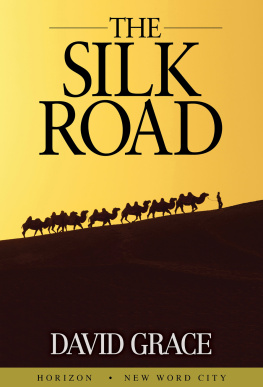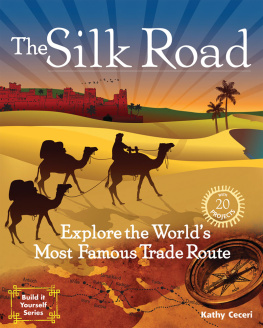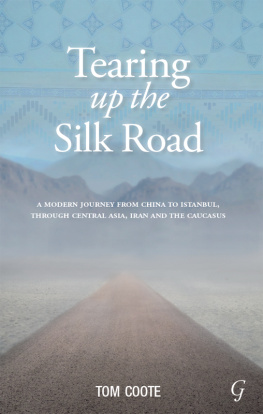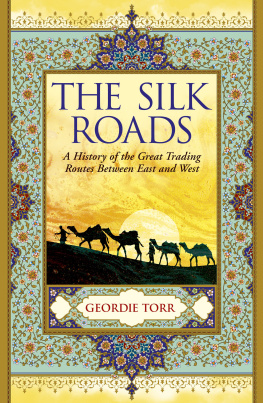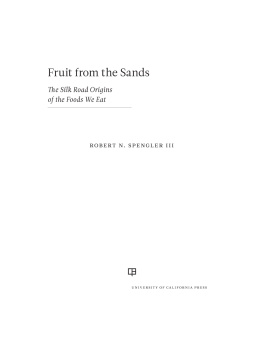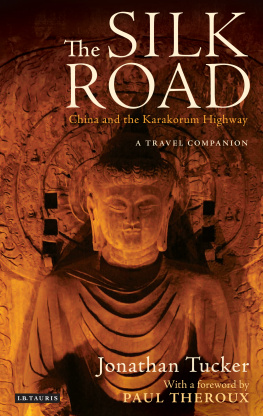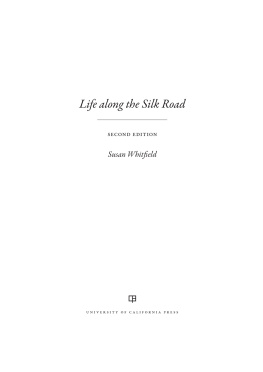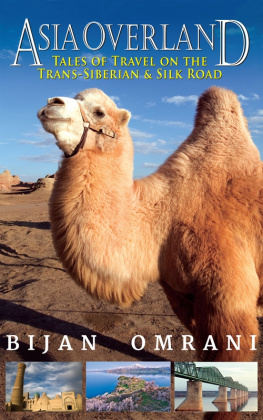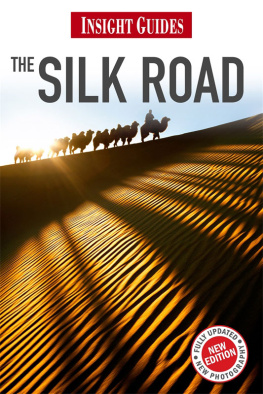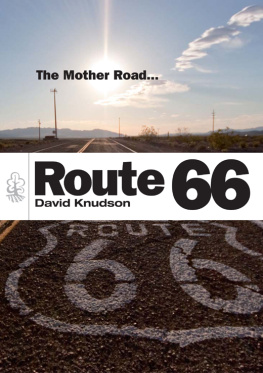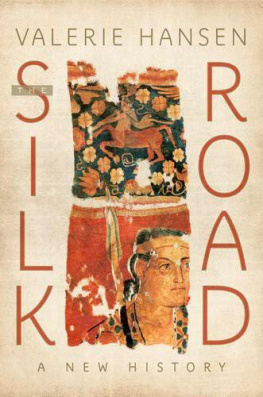David Grace - The Silk Road
Here you can read online David Grace - The Silk Road full text of the book (entire story) in english for free. Download pdf and epub, get meaning, cover and reviews about this ebook. year: 2016, publisher: New Word City, Inc., genre: Religion. Description of the work, (preface) as well as reviews are available. Best literature library LitArk.com created for fans of good reading and offers a wide selection of genres:
Romance novel
Science fiction
Adventure
Detective
Science
History
Home and family
Prose
Art
Politics
Computer
Non-fiction
Religion
Business
Children
Humor
Choose a favorite category and find really read worthwhile books. Enjoy immersion in the world of imagination, feel the emotions of the characters or learn something new for yourself, make an fascinating discovery.
- Book:The Silk Road
- Author:
- Publisher:New Word City, Inc.
- Genre:
- Year:2016
- Rating:3 / 5
- Favourites:Add to favourites
- Your mark:
- 60
- 1
- 2
- 3
- 4
- 5
The Silk Road: summary, description and annotation
We offer to read an annotation, description, summary or preface (depends on what the author of the book "The Silk Road" wrote himself). If you haven't found the necessary information about the book — write in the comments, we will try to find it.
Nothing in history sounds grander than a trade route, one of those thick bold lines on the statistical maps by which people have exchanged the products of their hands, minds, and sporadically, even hearts. Some of the routes have shaped history, rather than merely reflecting it. Primary among them is the Silk Road, the overland route across Asia that endured for more than 1,000 years as a crossroad from East to West. Here, in this essay by historian David Grace is the story of one of the great highways of trade.
David Grace: author's other books
Who wrote The Silk Road? Find out the surname, the name of the author of the book and a list of all author's works by series.
The Silk Road — read online for free the complete book (whole text) full work
Below is the text of the book, divided by pages. System saving the place of the last page read, allows you to conveniently read the book "The Silk Road" online for free, without having to search again every time where you left off. Put a bookmark, and you can go to the page where you finished reading at any time.
Font size:
Interval:
Bookmark:
Nothing in history sounds grander than a trade route, one of those thick, bold lines on maps by which humankind has exchanged the products of its hands, minds, and even hearts. It is the grandness of something at once heroic and faintly familiar. The principles of commerce are timeless and universal; we all stand at the end of some trade route or other. And we are reminded of lumbering lines of camels heaving across the sand, steamers treading through wide rivers, tea clippers sweeping gloriously before the trade winds.
Some of the routes have shaped history rather than merely reflecting it: The Atlantic mi grant route, by which new civilizations of the West were consolidated during the Victorian years, or the sea route to the Orient, which established the supremacy of the Europeans in southern Asia and shifted the equilibrium of the world.
One in particular, though it achieved an almost mystical fame, failed in its historical potential. It is the overland route across Asia, the Silk Road. For more than 1,000 years, it was one of the great highways of international trade, but the fortunes of this road have fluctuated down the centuries. Sometimes it followed this path, sometimes another, stretching from the frontiers of China at one end to the Mediterranean coast at the other. Nothing could be grander than this trans-Asian route. It was the tenuous link between the two supreme civilizations of the earth, and there was a time when it seemed almost ready to unite them, East and West, in the richness of a common culture. But it did not.
Tracks across open country do not generally follow a precise course. They spread or meander, and on one of the ancient desert trails, like the Haj route to Mecca, one can see the traces of 100,000 caravans strewn across the landscape in a million ruts . The route across Asia was scarcely a road, more a pattern of travel. Essentially, it was a corridor through the desolate uplands that separated north ern China, the home of one civilization, from the Mediterranean shoreline that was the perimeter of another.
The journey was difficult. To the south lay the impassable Himalayan Mountains; to the north, the Gobi Desert and foothills of Siberia. Between the two lay the dreadful Takla Makan desert of Sinkiang. Halfway to the Mediterranean, the route was blocked by the Pamir Mountains. Beyond were the steppes of Turkistan, the Persian highlands, and the Syrian Desert, before the caravans descended at last to the fertile shores, profits, and con solations of the Mediterranean.
The caravan route picked its way through these obstacles. It left China by the Jade Gate, the northwestern gate of China at the fortress town now called Y -men Kuan, and skirted the Takla Makan desert by a series of oases . Kashgar, at the foot of the Pamirs, was the midpoint. Once over the mountains, the caravans generally passed by way of Baghdad, Palmyra, and Samarkand to the port of Antioch at the northeastern corner of the Mediterranean. This was the principal route. Some caravans passed to the south of the Takla Makan desert, some to the north. There were several alterna tive routes through Persia, and at the Mediterranean end, trade was dispersed throughout the marts and seaports of the coastline. Feeder routes joined the main highway from the south - from the Ganges Delta at one end of India, and from the Indus basin through Afghanistan at the other. The route was about 4,000 miles from end to end, running across some of the most terrible and splendid country in the world - murderously cold in winter, in describably hot in summer - and through territories that had never given birth to civilizations of their own and were marked on the maps of the ancients as one huge and forbidding blank.
In the second century BCE, when this highway was dimly beginning to take shape, Central Asia was patchily controlled by a jumble of kingdoms, petty princelings, and bands of preda tory nomads. To the east, under the vigorous and benevolent rule of the Han emperors, China was enjoying one of its intermittent golden ages and was systematically pushing its boundaries to the west, where Rome had established its first footholds in Syria and was pressing eastward across Mesopotamia. Between them lay a power jungle. The kingdom of Parthia commanded the gap between the Caspian Sea and the Persian Gulf, its influence extending as far as the Pamirs. On the other side of the mountains, people called the Great Kushans were establishing an empire. In the wastelands of Sinkiang, fierce little powers rose and fell, while nomads from Tibet whooped about on ponies, plundering the route and raiding the oases . And from their strongholds to the north, the fearful Huns threatened all.
The western portion of the route, as far as the Pamirs, was dimly known to the West: Alexander had passed this way in the fourth century BCE on his way to conquer India. The eastern portion was known to the Chinese, whose first commercial interest in Central Asia was the celebrated celestial horse of Fergana - a much admired breed. Beyond the Pamirs, all was mystery .
The powers at each end of the route knew nothing of one another. Each was only a rumor. The Chinese had heard whispers of cultivated nations far beyond the Asian steppes . The Romans knew only that somewhere beyond India lived a mighty people. No one in the West had seen a Chinese. No one in the East had seen a European. Rome and China were like islands separated by an uncharted ocean.
By the middle of the first century BCE, the gap was closing. The four empires along the route had given it a certain security. The Han emperors had subdued much of the wild country on the western marches of China, south of the Gobi, making the route safe against Huns and Tibetans. The Kushans firmly policed the eastern approaches to the Pamirs; the Parthians controlled the western. The armies of Rome, under the command of the proconsul Crassus, were vigorously at war with Parthia in eastern Syria. Only a single great impulse - of war or of commerce - was needed to pierce the veil that lay between the Eastern and Western civilizations.
On a summer day in the year 53 BCE , Crassus and seven Roman legions crossed the Euphrates in pursuit of a Parthian force. When they reached the far bank, the enemy turned upon them, surround ing the Roman army, terrifying its soldiers w ith barbaric battle cries and drumbeats, and eventually inflicting one of the most disastrous defeats in the history of Rome. Crassus, his son, and 20,000 of his soldiers died. As the Parthians moved in for the kill, they suddenly unfurled majestic battle standards such as the Romans had never seen before - brilliantly dyed and made of a material unimaginably sumptuous. Tradition says it was the abrupt appearance of these standards that finally broke the morale of the legions; the banners certainly lingered in the Roman memory, and in the end, it was the fascination of that astonishing fabric, first glimpsed by Romans upon the battlefield of Carrhae, that brought the trans-Asia route to life and established a thin and transient con nection between Rome and China.
Later historians named the great highway for its principal raison dtre, and it has been known ever since as the Silk Road.
I need not explain, Gibbon nobly observes, that silk is origi nally spun from the bowels of a caterpillar and that it composes the golden tomb from whence a worm emerges in the form of a butter fly. It had first been woven by the Chinese, or so they liked to claim, some twenty-six centuries before, when the w ife of the em peror Huang-Ti had sponsored the growing of mulberry trees, the rearing of silkworms, and the reeling of silk and had even invented the loom. Silk became essential to the style and flavor of China. Noble families concerned themselves with its production, and at first, its use was reserved for the emperor himself; tribute was paid to him in silk. When its use spread to the commonalty, the prosperity of whole provinces depended upon it. Foreign visitors were dazzled by the splendor of Chinese ceremonial robes, and rolls of silk were used as currency by the imperial government. Silk was used to reward particular services to the state, even to pay state salaries, and people hoarded bales of silk as they were later to hoard gold or old masters.
Next pageFont size:
Interval:
Bookmark:
Similar books «The Silk Road»
Look at similar books to The Silk Road. We have selected literature similar in name and meaning in the hope of providing readers with more options to find new, interesting, not yet read works.
Discussion, reviews of the book The Silk Road and just readers' own opinions. Leave your comments, write what you think about the work, its meaning or the main characters. Specify what exactly you liked and what you didn't like, and why you think so.

